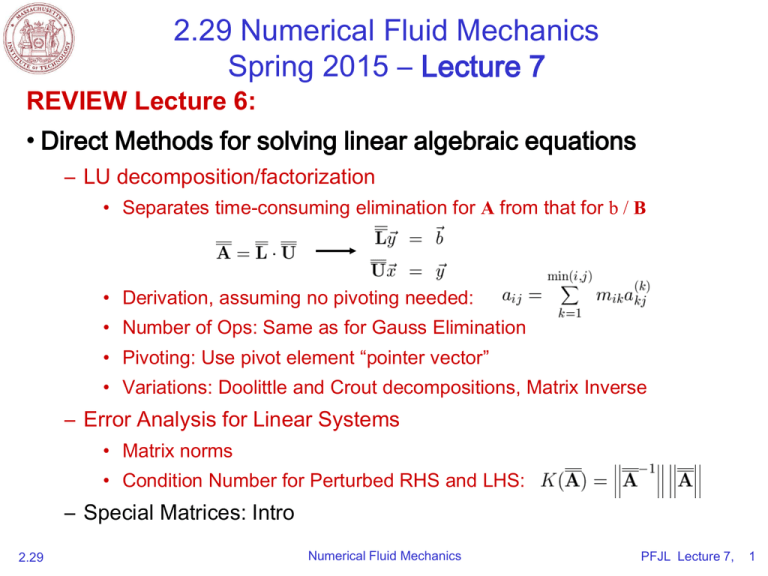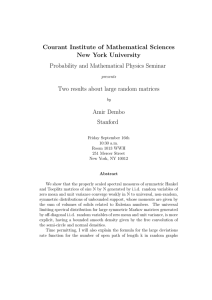2.29 Numerical Fluid Mechanics Spring 2015 – Lecture 7 REVIEW Lecture 6:
advertisement

2.29 Numerical Fluid Mechanics Spring 2015 – Lecture 7 REVIEW Lecture 6: • Direct Methods for solving linear algebraic equations – LU decomposition/factorization • Separates time-consuming elimination for A from that for b / B • Derivation, assuming no pivoting needed: • Number of Ops: Same as for Gauss Elimination • Pivoting: Use pivot element “pointer vector” • Variations: Doolittle and Crout decompositions, Matrix Inverse – Error Analysis for Linear Systems • Matrix norms • Condition Number for Perturbed RHS and LHS: – Special Matrices: Intro 2.29 Numerical Fluid Mechanics PFJL Lecture 7, 1 TODAY (Lecture 7): Systems of Linear Equations III • Direct Methods – Gauss Elimination – LU decomposition/factorization – Error Analysis for Linear Systems – Special Matrices: LU Decompositions • Tri-diagonal systems: Thomas Algorithm • General Banded Matrices – Algorithm, Pivoting and Modes of storage – Sparse and Banded Matrices • Symmetric, positive-definite Matrices – Definitions and Properties, Choleski Decomposition • Iterative Methods – Jacobi’s method – Gauss-Seidel iteration – Convergence 2.29 Numerical Fluid Mechanics PFJL Lecture 7, 2 Reading Assignment • Chapters 11 of “Chapra and Canale, Numerical Methods for Engineers, 2006/2010/2014.” – Any chapter on “Solving linear systems of equations” in references on CFD references provided. For example: chapter 5 of “J. H. Ferziger and M. Peric, Computational Methods for Fluid Dynamics. Springer, NY, 3rd edition, 2002” 2.29 Numerical Fluid Mechanics PFJL Lecture 7, 3 Special Matrices • Certain Matrices have particular structures that can be exploited, i.e. – Reduce number of ops and memory needs • Banded Matrices: – Square banded matrix that has all elements equal to zero, excepted for a band around the main diagonal. – Frequent in engineering and differential equations: • Tri-diagonal Matrices • Wider bands for higher-order schemes – Gauss Elimination or LU decomposition inefficient because, if pivoting is not necessary, all elements outside of the band remain zero (but direct GE/LU would manipulate these zero elements anyway) • Symmetric Matrices • Iterative Methods: – Employ initial guesses, than iterate to refine solution – Can be subject to round-off errors 2.29 Numerical Fluid Mechanics PFJL Lecture 7, 4 Special Matrices: Tri-diagonal Systems Example Forced Vibration of a String Example of a travelling pluse: f(x,t) xi Y(x,t) Consider the case of a Harmonic excitation f(x,t) =- f(x) cos(wt) Applying Newton’s law leads to the wave equation: With separation of variables, one obtains the equation for modal amplitudes, see eq. (1) below: Ytt c 2Yxx f ( x, t ) Y ( x, t ) (t ) y ( x ) Differential Equation for the amplitude: (1) Boundary Conditions: 2.29 Numerical Fluid Mechanics PFJL Lecture 7, 5 Special Matrices: Tri-diagonal Systems Forced Vibration of a String Finite Difference f(x,t) xi + O(h2) Y(x,t) Discrete Difference Equations + Harmonic excitation f(x,t) = f(x) cos(wt) Matrix Form: Differential Equation: y (1) Boundary Conditions: Tridiagonal Matrix If kh 1 or kh 3 symmetric, negative or positive definite: No pivoting needed Note: for 0< kh <1 Negative definite => Write: A’=-A and y ' y ' to render matrix positive definite 2.29 Numerical Fluid Mechanics PFJL Lecture 7, 6 Special Matrices: Tri-diagonal Systems General Tri-diagonal Systems: Bandwidth of 3 LU Decomposition Three steps for LU scheme: 1. Decomposition (GE): 2. Forward substitution 3. Backward substitution 2.29 Numerical Fluid Mechanics PFJL Lecture 7, 7 Special Matrices: Tri-diagonal Systems Thomas Algorithm By identification with the general LU decomposition, one obtains, 1. Factorization/Decomposition 2. Forward Substitution 3. Back Substitution i Number of Operations: Thomas Algorithm LU Factorization: Forward substitution: Back substitution: Total: 2.29 Numerical Fluid Mechanics 3*(n-1) operations 2*(n-1) operations 3*(n-1)+1 operations 8*(n-1) ~ O(n) operations PFJL Lecture 7, 8 Special Matrices: General, Banded Matrix p General Banded Matrix (p ≠ q) 0 q Banded Symmetric Matrix (p = q = b) 0 p super-diagonals q sub-diagonals w = p + q + 1 bandwidth 2.29 w = 2 b + 1 is called the bandwidth b is the half-bandwidth Numerical Fluid Mechanics PFJL Lecture 7, 9 Special Matrices: General, Banded Matrix LU Decomposition via Gaussian Elimination If No Pivoting: the zeros are preserved j j p i i 0 q 0 = = 0 0 aij( j ) mij ( j ) 0 a jj 2.29 (i ) uij a aij( i 1) mi,i1 ai(i1,1)j ij if j i or i j q (as gen. case) uij 0 (banded) Numerical Fluid Mechanics if i j or j i p (as gen. case) (banded) PFJL Lecture 7, 10 Special Matrices: General, Banded Matrix LU Decomposition via Gaussian Elimination With Partial Pivoting (by rows): Consider pivoting the 2 rows as below: p q Then, the bandwidth of L remains unchanged, q 0 = mij 0 if j i or i j q but the bandwidth of U becomes as that of A p q 0 uij 0 if i j or j i p q w w = p + 2 q +1 bandwidth 2.29 Numerical Fluid Mechanics PFJL Lecture 7, 11 Special Matrices: General, Banded Matrix Compact Storage Needed for Pivoting only Diagonal (length n) p q q q 0 0 i p i n–q 0 0 j j’=j – i+ q Matrix size: n2 2.29 Matrix size: n (p+2q+1) Numerical Fluid Mechanics PFJL Lecture 7, 12 Special Matrices: Sparse and Banded Matrix ‘Skyline’ Systems (typically for symmetric matrices) 0 ….. ‘Skyline’ ….. Storage 0 Pointers 1 4 9 11 16 20 ….. Skyline storage applicable when no pivoting is needed, e.g. for banded, symmetric, and positive definite matrices: FEM and FD methods. Skyline solvers are usually based on Cholesky factorization (which preserves the skyline) 2.29 Numerical Fluid Mechanics PFJL Lecture 7, 13 Special Matrices: Symmetric (Positive-Definite) Matrix Symmetric Coefficient Matrices: • If no pivoting, the matrix remains symmetric after Gauss Elimination/LU decompositions Proof: Show that if aij( k ) a (jik ) then aij( k 1) a (jik 1) using: • Gauss Elimination symmetric (use only the upper triangular portion of A): aij( k 1) aij( k ) mik akj( k ) aki( k ) mik ( k ) , akk i k 1, k 2,..., n j i, i 1,..., n • About half the total number of ops than full GE 2.29 Numerical Fluid Mechanics PFJL Lecture 7, 14 Special Matrices: Symmetric, Positive Definite Matrix 1. Sylvester Criterion: A symmetric matrix is Positive Definite if and only if: det(Ak) > 0 for k=1,2,…,n, where Ak is matrix of k first lines/columns Symmetric Positive Definite matrices frequent in engineering 2. For a symmetric positive definite A, one thus has the following properties a) The maximum elements of A are on the main diagonal b) For a Symmetric, Positive Definite A: c) The elimination is stable: No pivoting needed aii( k 1) 2 aii( k ) . To show this, use akj2 akk a jj in aij( k 1) aij( k ) mik akj( k ) aki( k ) mik ( k ) , akk 2.29 i k 1, k 2,..., n j i, i 1,..., n Numerical Fluid Mechanics PFJL Lecture 7, 15 Special Matrices: Symmetric, Positive Definite Matrix The general GE aij( k 1) aij( k ) mik akj( k ) aki( k ) mik ( k ) , i k 1, k 2,..., n akk j i, i 1,..., n becomes: Choleski Factorization Complex Conjugate where No pivoting needed Complex Conjugate and Transpose 2.29 Numerical Fluid Mechanics PFJL Lecture 7, 16 Linear Systems of Equations: Iterative Methods Sparse (large) Full-bandwidth Systems (frequent in practice) x 0 x x 0 0 x x 0 0 x 0 0 x x x 0 0 x Iterative Methods are then efficient Analogous to iterative methods obtained for roots of equations, i.e. Open Methods: Fixed-point, Newton-Raphson, Secant Example of Iteration equation A x b A xb 0 x xA xb 0 x k 1 x k A x k b ( A I) x k b 0 0 0 General Stationary Iteration Formula xk 1 B x k c k 0,1,2,... 0 0 ps: B and c could be function of k (non-stationary) 2.29 Compatibility condition for Ax=b to be the solution: Write c C b 1 ( I B ) A C or B I C A 1 1 A b B A b Cb Numerical Fluid Mechanics PFJL Lecture 7, 17 Linear Systems of Equations: Iterative Methods Convergence Convergence Convergence Analysis Iteration – Matrix form Sufficient Condition for Convergence: 2.29 Numerical Fluid Mechanics PFJL Lecture 7, 18 ||B||<1 for a chosen matrix norm Infinite norm often used in practice “Maximum Column Sum” “Maximum Row Sum” “The Frobenius norm” (also called Euclidean norm)”, which for matrices differs from: “The l-2 norm” (also called spectral norm) 2.29 Numerical Fluid Mechanics PFJL Lecture 7, 19 Linear Systems of Equations: Iterative Methods Convergence: Necessary and Sufficient Condition Convergence Convergence Analysis Iteration – Matrix form Necessary and Sufficient Condition for Convergence: Spectral radius of B is smaller than one: (B) max i 1, where i eigenvalue(Bnn ) i 1... n (proof: use eigendecomposition of B) 2.29 (This ensures ||B||<1) Numerical Fluid Mechanics PFJL Lecture 7, 20 MIT OpenCourseWare http://ocw.mit.edu 2.29 Numerical Fluid Mechanics Spring 2015 For information about citing these materials or our Terms of Use, visit: http://ocw.mit.edu/terms.







